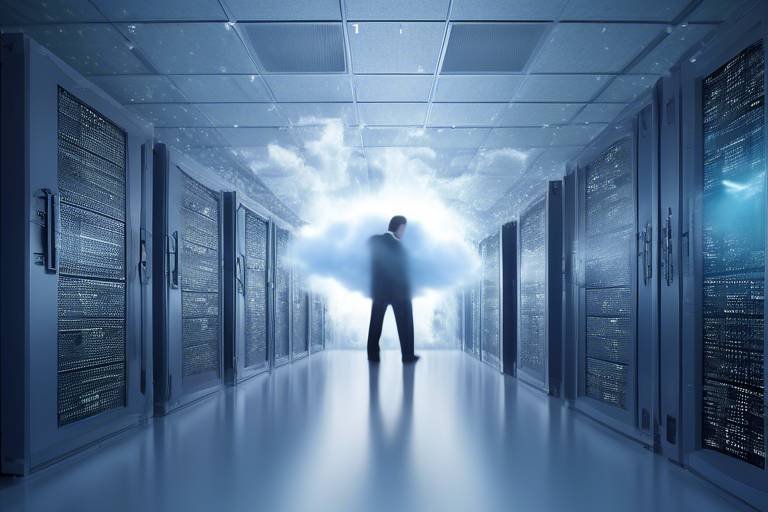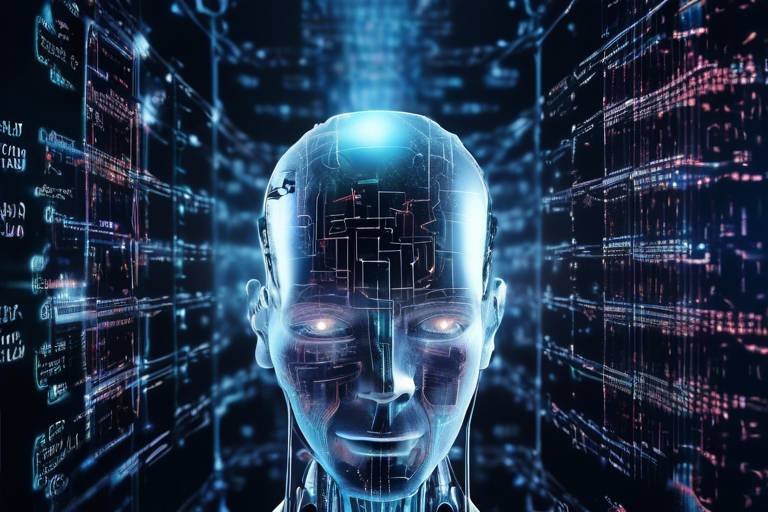Innovations in Smart Water Conservation Technologies
In a world where water scarcity is becoming an increasingly pressing issue, the need for innovative solutions in water conservation has never been more critical. This article explores cutting-edge technologies designed to enhance water conservation efforts, highlighting their significance, functionality, and impact on sustainability in various sectors. Imagine a future where every drop of water is utilized efficiently, where waste is minimized, and where technology plays a pivotal role in preserving our planet's most precious resource. The innovations in smart water conservation technologies are not just dreams; they are becoming a reality, transforming how we manage and use water.
These technologies are revolutionizing traditional practices, making them smarter and more efficient. From agriculture to urban settings, the integration of sensor technology, data analytics, and artificial intelligence is paving the way for a more sustainable future. As we delve into each of these innovations, you'll see how they not only help in conserving water but also contribute to a broader environmental impact, ensuring that future generations have access to clean and abundant water.
In this exploration, we will cover various aspects of these innovations, including smart irrigation systems, water leak detection technologies, and more. Each technology plays a unique role in the ecosystem of water management, working together to create a comprehensive approach to conservation. So, let's dive into the details and discover how these advancements are shaping the future of water sustainability.
Smart irrigation systems utilize sensors and data analytics to optimize water usage in agriculture, reducing waste while ensuring crops receive adequate hydration for healthy growth. These systems are equipped with moisture sensors that monitor soil conditions, allowing farmers to water their crops only when necessary. This precision not only conserves water but also enhances crop yield and quality. Imagine a farmer being able to predict the exact moment when their plants need water, rather than relying on guesswork or a fixed schedule. This is the power of smart irrigation!
Advanced leak detection technologies employ acoustic sensors and machine learning to identify leaks in pipelines, helping municipalities and homeowners conserve water and reduce repair costs. These systems can detect even the smallest leaks that are often invisible to the naked eye, preventing significant water loss. By addressing leaks promptly, cities can save millions of gallons of water each year, contributing to sustainability efforts and lowering water bills for residents.
Innovative rainwater harvesting systems capture and store rainwater for various uses, promoting sustainable water management practices and reducing reliance on traditional water sources. These systems can be as simple as a barrel placed under a downspout or as complex as a fully integrated system that filters and stores rainwater for household use. By harnessing nature's free resource, communities can significantly lower their water consumption from municipal sources.
Greywater recycling technologies treat and reuse water from sinks, showers, and washing machines, providing an eco-friendly alternative for irrigation and toilet flushing. This not only reduces the demand for fresh water but also minimizes wastewater that would otherwise go to treatment plants. Think of it as giving a second life to water that has already served its purpose!
Smart water meters provide real-time data on water usage, enabling consumers to monitor their consumption patterns and make informed decisions to reduce waste. With these meters, individuals can track their water usage through mobile apps, gaining insights into their habits and identifying areas for improvement. This transparency fosters a culture of conservation, empowering people to take action.
Advanced sensors and IoT devices continuously monitor water quality, ensuring safe drinking water supplies while enabling rapid response to contamination events. These technologies can detect harmful substances and alert authorities immediately, safeguarding public health and maintaining trust in water supplies.
Recent advancements in desalination technology aim to make the process more energy-efficient and cost-effective, providing a viable solution for water-scarce regions. By converting seawater into fresh water, these innovations offer hope to communities facing severe water shortages. Imagine coastal cities being able to tap into the vast oceans surrounding them to meet their water needs!
AI-driven analytics optimize water distribution and usage, predicting demand patterns and improving efficiency in both urban and agricultural settings. By analyzing vast amounts of data, AI can help utilities manage resources more effectively, ensuring that water is allocated where it is needed most. This smart approach reduces waste and enhances the overall resilience of water systems.
Raising awareness about smart water conservation technologies is essential for community engagement, encouraging responsible water usage and fostering sustainable practices among individuals and businesses. Educational programs, workshops, and community events can empower people with the knowledge they need to make informed choices about their water use. When communities understand the importance of conservation, they are more likely to adopt these technologies and practices.
- What are smart irrigation systems? Smart irrigation systems use sensors and data analytics to optimize water use in agriculture.
- How do water leak detection technologies work? They employ acoustic sensors and machine learning to identify leaks in pipelines.
- What is greywater recycling? Greywater recycling treats and reuses water from sinks and showers for irrigation and toilet flushing.
- How can I monitor my water usage? Smart water meters provide real-time data on your water consumption.

Smart Irrigation Systems
In the world of agriculture, where every drop of water counts, are revolutionizing the way we manage this precious resource. Imagine a system that knows exactly when and how much to water your crops, ensuring they thrive without wasting a single drop. This is not just a dream; it’s a reality thanks to the integration of advanced sensors and data analytics.
These systems work by utilizing a network of sensors that monitor soil moisture levels, weather conditions, and even crop health. When the sensors detect that the soil is dry, the system automatically activates the irrigation process, delivering just the right amount of water needed. This not only conserves water but also promotes healthier crops, leading to better yields. With climate change and water scarcity becoming pressing issues, the importance of these systems cannot be overstated.
Furthermore, smart irrigation systems can be controlled remotely through mobile applications, allowing farmers to manage their irrigation schedules from anywhere. This level of control is akin to having a personal assistant for your farm, making it easier to adapt to changing weather conditions or unexpected droughts. The ability to access real-time data means farmers can make informed decisions, optimizing their water usage and reducing costs.
To give you a clearer picture, let's take a look at how these systems work in a typical scenario:
| Component | Function |
|---|---|
| Sensors | Measure soil moisture, temperature, and weather conditions. |
| Controller | Processes data from sensors and activates irrigation when needed. |
| Irrigation System | Delivers water to crops through drip lines or sprinklers. |
| Mobile App | Allows remote monitoring and control of the irrigation system. |
But the benefits don’t stop there! These systems also contribute to environmental sustainability by reducing runoff and erosion. By applying water directly at the root zone, they minimize evaporation and ensure that every drop is effectively utilized. As a result, farmers can maintain healthier soils and contribute to the overall health of the ecosystem.
In summary, smart irrigation systems are not just a luxury; they are becoming a necessity in modern agriculture. They represent a significant step toward sustainable farming practices, ensuring that we can meet the food demands of an ever-growing population while conserving our vital water resources. So, the next time you think about irrigation, remember that technology is paving the way for a brighter, more sustainable future.

Water Leak Detection Technologies
In an era where water scarcity is becoming a pressing issue, the need for effective has never been more critical. Imagine a world where every drop of water is accounted for—where leaks are detected before they can cause significant damage or waste. These advanced systems utilize a combination of acoustic sensors, machine learning, and real-time data analytics to identify leaks in pipelines with remarkable precision. By pinpointing leaks early on, municipalities and homeowners can conserve valuable water resources and significantly reduce repair costs.
So, how do these technologies actually work? At their core, they employ a network of sensors strategically placed along pipelines. These sensors listen for unusual sounds that indicate a leak, much like how a doctor might use a stethoscope to detect irregularities in a heartbeat. Once a potential leak is detected, the data is transmitted to a central monitoring system, where sophisticated algorithms analyze the information. This process is akin to having a personal water detective on the job, tirelessly working to ensure that no water is wasted.
One of the most exciting aspects of these leak detection technologies is their ability to learn and adapt. Through machine learning, the system improves its accuracy over time, learning from past leak events and adjusting its detection methods accordingly. This means that not only can these systems identify leaks more effectively, but they can also predict potential future issues before they arise. This proactive approach is revolutionizing how we manage our water resources, making it easier for communities to maintain their infrastructure while preserving our precious water supply.
Moreover, the impact of these technologies extends beyond just water conservation. By reducing the frequency and severity of leaks, municipalities can save on costly repairs and maintenance. This translates to lower water bills for consumers and a more sustainable approach to water management. In fact, studies have shown that implementing advanced leak detection systems can reduce water loss by as much as 30% to 50%. That's a significant amount of water that can be redirected to where it's needed most—be it agriculture, drinking supplies, or recreational areas.
To illustrate the effectiveness of these technologies, consider the following table that highlights the benefits of using advanced leak detection systems compared to traditional methods:
| Feature | Traditional Methods | Advanced Leak Detection |
|---|---|---|
| Leak Detection Speed | Days to weeks | Real-time |
| Accuracy | Moderate | High |
| Cost of Repair | High due to extensive damage | Lower due to early detection |
| Water Loss | High | Reduced by up to 50% |
In conclusion, are not just a luxury; they are a necessity in today's world. With the ability to conserve water, reduce costs, and enhance infrastructure management, these systems represent a significant leap forward in our quest for sustainable water solutions. As communities continue to adopt these technologies, we can look forward to a future where water is used more wisely, ensuring that this vital resource remains available for generations to come.
Q1: How do water leak detection technologies work?
A1: These technologies utilize acoustic sensors and machine learning algorithms to detect unusual sounds in pipelines, indicating potential leaks. The data is analyzed in real-time to pinpoint the exact location of the leak.
Q2: What are the benefits of using advanced leak detection systems?
A2: Benefits include real-time leak detection, high accuracy, reduced repair costs, and significant water conservation—potentially reducing water loss by up to 50%.
Q3: Can these systems predict future leaks?
A3: Yes, through machine learning, these systems can learn from past events and improve their detection methods, allowing them to predict potential future leaks before they occur.

Rainwater Harvesting Solutions
Imagine a world where every drop of rain is captured and utilized, transforming what was once wasted into a valuable resource. are at the forefront of this revolution, offering innovative ways to collect, store, and use rainwater for various applications. These systems not only help reduce reliance on traditional water sources but also promote sustainable water management practices that can significantly benefit both households and communities.
At its core, rainwater harvesting involves the collection of rainwater from rooftops or other surfaces and directing it into storage systems. This process can be as simple as a barrel placed under a downspout or as complex as an integrated system designed for large-scale use. The beauty of rainwater harvesting lies in its versatility; it can be used for irrigation, flushing toilets, and even for drinking water, provided it is properly treated.
One of the key advantages of rainwater harvesting is its potential to alleviate the pressure on municipal water supplies, especially in areas prone to drought. By capturing rainwater, households can significantly reduce their water bills while contributing to the conservation of this precious resource. For instance, a typical household can collect thousands of gallons of rainwater each year, depending on the size of the roof and the amount of rainfall received.
To give you a clearer picture of how effective rainwater harvesting can be, consider the following table that outlines the average annual rainfall in various regions and the potential water savings:
| Region | Average Annual Rainfall (in inches) | Potential Water Savings (in gallons) |
|---|---|---|
| Desert Areas | 8 | 1,200 |
| Suburban Areas | 30 | 5,000 |
| Tropical Regions | 70 | 12,000 |
Implementing a rainwater harvesting system can also enhance stormwater management. By reducing runoff, these systems help prevent flooding and erosion, protecting local ecosystems. Furthermore, rainwater is typically softer than groundwater, which means it contains fewer minerals and is often better for irrigation, leading to healthier plants and landscapes.
However, as with any system, there are considerations to keep in mind. Proper maintenance of rainwater harvesting systems is crucial to ensure water quality and system efficiency. Regular cleaning of storage tanks and filtration systems can help prevent contamination and ensure that the water is safe for its intended use. Additionally, it's essential to check local regulations, as some areas have specific guidelines regarding the installation and use of rainwater harvesting systems.
In conclusion, rainwater harvesting solutions represent a powerful tool in the fight for sustainable water management. By capturing and utilizing rainwater, we can not only reduce our environmental footprint but also foster a culture of conservation that benefits everyone. So, the next time it rains, think about the potential that lies in those droplets, and consider how you can harness that power in your own home or community.
- What is rainwater harvesting? Rainwater harvesting is the collection and storage of rainwater for reuse, typically for irrigation, flushing toilets, or even drinking water.
- Is rainwater safe to drink? With proper treatment and filtration, rainwater can be safe to drink. However, it's essential to follow local guidelines and regulations.
- How much water can I collect? The amount of water you can collect depends on the size of your roof and the amount of rainfall in your area.
- What are the maintenance requirements? Regular cleaning and maintenance of storage tanks and filtration systems are necessary to ensure water quality and system efficiency.

Greywater Recycling Systems
In our quest for sustainable living, greywater recycling systems are emerging as a game-changer. But what exactly is greywater? Simply put, it's the water that comes from our sinks, showers, and washing machines—essentially, water that has been used but is not contaminated with sewage. This means it can be treated and reused for various purposes, significantly reducing the demand for fresh water. Imagine the impact if every household could recycle this water! It’s like finding a hidden treasure in your own home, waiting to be tapped into.
Greywater recycling systems work by collecting this water, treating it, and then redistributing it for non-potable uses such as irrigation, toilet flushing, and even washing clothes. The technology behind these systems is becoming increasingly sophisticated, utilizing filtration and biological treatment methods to ensure that the recycled water is safe and effective. For instance, some systems use biofilters that harness the power of microorganisms to break down contaminants, making the water suitable for reuse.
One of the most appealing aspects of greywater recycling is its potential to conserve a significant amount of water. According to estimates, a typical household can generate around 50 to 80 gallons of greywater per day. By recycling just a fraction of that, we can contribute to a more sustainable future. Not only does this reduce the strain on municipal water supplies, but it also lowers water bills—it's like getting a discount on something we all need!
However, as with any technology, there are considerations to keep in mind. Installation of greywater systems requires an upfront investment, and local regulations may dictate how these systems can be used. It’s essential to consult with professionals who understand the legal landscape and can design a system that meets both your needs and compliance standards. In addition, homeowners should be aware of the types of soaps and detergents they use, as certain chemicals can hinder the recycling process.
To give you a clearer picture, here’s a simple comparison of traditional water use versus greywater recycling:
| Aspect | Traditional Water Use | Greywater Recycling |
|---|---|---|
| Source | Freshwater supplies | Used water from sinks, showers, etc. |
| Applications | Drinking, cooking, bathing | Irrigation, toilet flushing, washing |
| Environmental Impact | Higher demand on freshwater sources | Reduces freshwater consumption |
| Cost | Higher water bills | Lower water bills, potential savings |
In conclusion, greywater recycling systems not only promote sustainability but also encourage a culture of conservation. By making small changes in our water usage habits, we can contribute to a larger movement towards a greener future. So, why not take a moment to consider how you can implement greywater recycling in your home? It’s a simple adjustment that can lead to significant benefits.
- What is greywater? Greywater is the wastewater generated from household activities such as bathing, washing dishes, and laundry, excluding toilet waste.
- Can all greywater be reused? Not all greywater is suitable for reuse. It's important to treat it properly to ensure it’s safe for non-potable applications.
- How much water can be recycled? A typical household can recycle 50 to 80 gallons of greywater per day, depending on usage.
- Are there regulations for greywater recycling? Yes, regulations vary by location, so it's essential to check local laws before installing a greywater system.

Smart Metering Solutions
In today's fast-paced world, have emerged as a game-changer in the realm of water conservation. These innovative devices are not just about measuring water usage; they serve as a critical tool for consumers and municipalities alike to manage their water resources more efficiently. Imagine having the ability to track your water consumption in real-time, just like you can with your electricity or gas. This technology empowers users to make informed decisions, ultimately leading to significant water savings.
So, how does it work? Smart meters use advanced communication technologies to transmit data directly to water providers and consumers. This means that instead of waiting for a monthly bill, you can access your water usage statistics anytime, anywhere, through a smartphone app or an online portal. This immediacy not only promotes accountability but also encourages users to be more mindful of their consumption patterns. For instance, if you notice a spike in your usage, you might investigate potential leaks or consider adjusting your habits.
One of the most exciting aspects of smart metering solutions is their ability to provide detailed insights into water usage. Users can view their consumption in various formats, such as:
- Daily averages
- Peak usage times
- Comparative analysis with previous months
This kind of data can be invaluable for identifying trends and making adjustments. For example, if your water usage peaks during certain times of the day, you might consider shifting your irrigation schedule or reducing water-intensive activities during those hours.
Moreover, smart meters are not just beneficial for individual households; they also play a crucial role in municipal water management. By collecting and analyzing data from numerous smart meters, cities can identify areas of high consumption, detect leaks in the distribution system, and optimize their water supply strategies. This data-driven approach leads to better planning and resource allocation, ultimately resulting in a more sustainable water management system.
In addition to conservation, smart metering solutions can also enhance customer service. Automated alerts can notify users of unusual consumption patterns, which may indicate a leak or malfunction. This proactive approach not only saves water but also reduces repair costs and prevents further damage. Imagine receiving a text alert that your water usage has spiked unexpectedly; you can quickly check for leaks or other issues before they escalate.
Furthermore, the integration of smart metering solutions with other smart technologies, such as home automation systems, can lead to even greater efficiencies. For instance, a smart irrigation system could adjust its watering schedule based on real-time data from the smart water meter, ensuring that plants receive just the right amount of water without waste.
As we move forward, the adoption of smart metering solutions will be pivotal in our collective journey towards sustainable water usage. By embracing these technologies, we can not only conserve precious resources but also foster a culture of responsibility and awareness regarding water consumption. After all, every drop counts!
- What are smart meters? Smart meters are advanced devices that provide real-time data on water usage, enabling users to monitor and manage their consumption effectively.
- How do smart meters help in water conservation? They allow users to track their water usage patterns, identify leaks, and adjust their habits, leading to reduced waste.
- Can smart meters detect leaks? Yes, many smart meters can send alerts if they detect unusual spikes in usage, indicating a potential leak.
- Are smart metering solutions expensive? While the initial investment might be higher than traditional meters, the long-term savings from reduced water waste often outweigh the costs.

Water Quality Monitoring Technologies
In today's world, ensuring the safety and quality of our drinking water is more crucial than ever. With the increasing pollution and rising population, have emerged as a vital component in safeguarding our water supplies. These innovative systems utilize advanced sensors and Internet of Things (IoT) devices to continuously monitor various parameters of water quality, including pH levels, turbidity, dissolved oxygen, and the presence of harmful contaminants.
Imagine being able to detect a problem in your water supply before it even reaches your tap. That’s the power of modern water quality monitoring technologies! These systems can provide real-time data, alerting municipalities and homeowners to any irregularities that may indicate contamination. By utilizing machine learning algorithms, these technologies can analyze historical data and predict potential issues, allowing for proactive measures to be taken.
One of the standout features of these technologies is their ability to integrate with existing water management systems. For instance, many water treatment facilities are now incorporating automated monitoring systems that can communicate directly with their operational software. This integration not only streamlines the monitoring process but also enhances the overall efficiency of water treatment operations. The result? Cleaner, safer drinking water for communities.
Moreover, these monitoring technologies aren’t just for large municipalities. Homeowners can also benefit from affordable, user-friendly devices that provide insights into their personal water quality. With a simple app on their smartphones, users can check their water's safety and receive alerts if any parameters fall outside acceptable ranges. This level of transparency empowers individuals to take control of their water consumption and quality, fostering a culture of responsibility.
To illustrate the impact of water quality monitoring technologies, consider the following table that outlines some key benefits:
| Benefit | Description |
|---|---|
| Real-Time Monitoring | Continuous tracking of water quality parameters ensures immediate detection of issues. |
| Predictive Analytics | Utilizes historical data to anticipate potential contamination events. |
| Cost Efficiency | Reduces the need for extensive manual testing and lowers operational costs. |
| Community Engagement | Increases public awareness and involvement in water quality issues. |
As we move forward, the importance of these technologies cannot be overstated. They not only help in ensuring that our drinking water is safe but also play a critical role in protecting our natural water bodies from pollution. By investing in water quality monitoring, we are investing in the health of our communities and the sustainability of our environment.
- What are the main parameters monitored by water quality technologies? These typically include pH, turbidity, dissolved oxygen, and the presence of contaminants like heavy metals and bacteria.
- How do these technologies help in emergency situations? They provide real-time alerts that enable quick responses to contamination, potentially saving lives and preventing widespread health issues.
- Can homeowners use these technologies? Yes, there are various affordable devices available for home use that allow individuals to monitor their water quality.
- Are these systems expensive to implement? While initial costs can vary, the long-term savings and benefits often outweigh the investment, making them cost-effective solutions.

Desalination Innovations
As the world grapples with the escalating water crisis, are emerging as a beacon of hope, particularly in arid regions where freshwater resources are scarce. Desalination, the process of removing salt and other impurities from seawater, has traditionally been energy-intensive and costly. However, recent advancements in technology are revolutionizing this field, making desalination more efficient and accessible than ever before.
One of the most significant breakthroughs in desalination technology is the development of reverse osmosis membranes that are not only more effective but also more durable. These membranes act as a barrier, allowing water molecules to pass through while blocking larger salt ions. Cutting-edge materials, such as graphene and advanced polymer composites, are being utilized to enhance the performance of these membranes, leading to higher water recovery rates and lower energy consumption.
Furthermore, the integration of renewable energy sources into desalination processes is transforming the landscape. Solar and wind energy are being harnessed to power desalination plants, drastically reducing their carbon footprint. For instance, solar desalination systems utilize solar stills or photovoltaic panels to convert sunlight into energy, which is then used to drive the desalination process. This not only makes desalination more sustainable but also lessens dependency on fossil fuels.
Another exciting innovation is the use of nanotechnology in the desalination process. Researchers are exploring the potential of nanomaterials to create more efficient filtration systems that can operate at lower pressures and temperatures. This could significantly cut down on the operational costs associated with desalination, making it a more viable option for countries facing water scarcity.
| Innovation | Description | Benefits |
|---|---|---|
| Advanced Membranes | Utilization of graphene and polymer composites | Higher efficiency and durability |
| Renewable Energy Integration | Using solar and wind energy for desalination | Reduced carbon footprint and operational costs |
| Nanotechnology | Employing nanomaterials for filtration | Lower energy requirements and costs |
In addition to these technological advancements, there is a growing emphasis on smart desalination systems that incorporate IoT (Internet of Things) devices. These systems enable real-time monitoring and management of desalination processes, optimizing performance and resource usage. By leveraging data analytics, operators can predict maintenance needs, adjust operational parameters, and enhance overall efficiency.
As we look to the future, the role of desalination in addressing global water shortages cannot be overstated. While it is not a one-size-fits-all solution, the innovations in this field are paving the way for a more sustainable approach to water management. Countries that invest in these technologies will not only ensure a reliable water supply for their populations but also contribute to global efforts in combating climate change.
- What is desalination? Desalination is the process of removing salt and impurities from seawater to produce freshwater.
- How does reverse osmosis work? Reverse osmosis uses a semi-permeable membrane to separate salt and impurities from water, allowing only clean water to pass through.
- Are desalination plants environmentally friendly? With advancements in renewable energy and efficient technologies, modern desalination plants aim to minimize their environmental impact.
- What are the main challenges of desalination? High energy consumption and costs have been traditional challenges, but innovations are addressing these issues.

Artificial Intelligence in Water Management
Artificial Intelligence (AI) is revolutionizing the way we manage and conserve water resources. Imagine a world where water distribution is as precise as a surgeon's scalpel—this is the promise of AI in water management. By harnessing advanced algorithms and machine learning, AI can analyze vast amounts of data to predict water demand, optimize usage, and even detect inefficiencies in real-time. This technology is not just a futuristic dream; it's already being implemented in various sectors, from agriculture to urban water supply systems.
One of the most significant advantages of AI in water management is its ability to forecast demand patterns. For instance, AI systems can examine historical water usage data, weather patterns, and even social events to predict when and where water will be needed most. This predictive capability allows for better resource allocation, ensuring that water is available where it is needed without unnecessary waste. Think of it as having a personal assistant who knows your schedule and prepares everything in advance—only here, we’re talking about our precious water resources.
Furthermore, AI can significantly enhance the efficiency of irrigation systems in agriculture. By integrating AI with smart irrigation technologies, farmers can receive precise recommendations on when to water their crops and how much water to use. This not only conserves water but also improves crop yields. For example, a farmer using AI-driven irrigation can reduce water usage by up to 30% while still ensuring that their crops thrive. It's like having a weather forecast specifically for your field, allowing you to make informed decisions that benefit both your wallet and the environment.
AI also plays a crucial role in detecting leaks and inefficiencies within water distribution systems. Traditional methods of leak detection can be slow and labor-intensive, often leading to significant water loss before issues are resolved. However, with AI-enhanced monitoring systems equipped with sensors, municipalities can identify leaks almost instantaneously. These systems analyze sound patterns and flow rates to pinpoint anomalies, allowing for quicker repairs and less wasted water. It’s like having an ever-vigilant guardian watching over our water supply, ready to alert us at the first sign of trouble.
To illustrate the impact of AI in water management, consider the following table that highlights some key benefits:
| Benefit | Description |
|---|---|
| Predictive Analytics | Forecasts water demand based on various factors, ensuring efficient resource allocation. |
| Improved Irrigation | Optimizes water usage in agriculture, leading to reduced waste and enhanced crop health. |
| Leak Detection | Identifies leaks in real-time, minimizing water loss and repair costs. |
| Data-Driven Decision Making | Provides actionable insights for better management of water resources. |
In conclusion, the integration of Artificial Intelligence in water management is not just a technological advancement; it's a necessity in our quest for sustainability. As we face increasing water scarcity and environmental challenges, leveraging AI can lead us toward a future where water is managed more effectively, ensuring that this vital resource is available for generations to come. Embracing these innovations is crucial, and the time to act is now.
- What is AI in water management? AI in water management refers to the use of artificial intelligence technologies to optimize water distribution, predict demand, and enhance conservation efforts.
- How does AI help in agriculture? AI helps farmers optimize irrigation schedules based on real-time data, leading to reduced water usage while maintaining crop health.
- Can AI detect leaks in water systems? Yes, AI can analyze data from sensors to detect leaks in real-time, allowing for quicker repairs and less water waste.
- Why is AI important for sustainability? AI enables more efficient use of water resources, helping to address water scarcity and promote sustainable practices.

Public Awareness and Education Initiatives
In our fast-paced world, where every drop counts, play a crucial role in fostering responsible water usage. Imagine a community where every individual understands the significance of water conservation—this vision is not just a dream but a reality we can work towards through effective outreach and education programs. These initiatives aim to enlighten people about the importance of conserving water, the technologies available to aid in this effort, and how they can personally contribute to sustainability.
One of the most effective ways to raise awareness is through community workshops and seminars. These events provide a platform for experts to share their knowledge about smart water conservation technologies, such as smart irrigation systems and greywater recycling. Participants can engage in discussions, ask questions, and even see demonstrations of these technologies in action. By making the information accessible and relatable, individuals are more likely to adopt these practices in their own lives.
Moreover, leveraging social media and digital platforms can amplify the reach of these initiatives. Campaigns that showcase success stories and practical tips for reducing water consumption can engage a broader audience. For instance, a video series featuring local families who have implemented rainwater harvesting or smart metering solutions can inspire others to follow suit. The key here is to create content that resonates with the audience—content that is not only informative but also entertaining and shareable.
Schools also play a vital role in educating the younger generation about water conservation. Integrating water conservation topics into the curriculum can instill a sense of responsibility in children from an early age. Hands-on activities, such as building simple water-saving devices or participating in local clean-up events, can make learning fun and impactful. When children understand the value of water and the technologies that help conserve it, they are more likely to carry these lessons into adulthood.
To further enhance these educational efforts, partnerships with local businesses and organizations can be beneficial. Collaborating with environmental NGOs or utility companies can provide additional resources and expertise. For example, local businesses can sponsor workshops or provide discounts on water-saving devices, making them more accessible to the community. Such collaborations can create a ripple effect, encouraging more people to get involved and take action.
Ultimately, the goal of these initiatives is to create a culture of sustainable water usage. When communities are informed and engaged, they can make better choices that not only benefit their households but also contribute to the overall health of the environment. As we move forward, it’s essential to continue focusing on education and awareness as key components in the fight against water scarcity and environmental degradation.
Here are some common questions regarding public awareness and education initiatives for water conservation:
| Question | Answer |
|---|---|
| What types of workshops are available for water conservation? | Workshops often cover topics like smart irrigation, rainwater harvesting, and greywater recycling, featuring both theoretical knowledge and practical demonstrations. |
| How can social media help in water conservation efforts? | Social media can spread awareness quickly by sharing success stories, tips, and engaging content that encourages people to adopt water-saving practices. |
| Why is it important to educate children about water conservation? | Educating children fosters a sense of responsibility towards water resources, encouraging them to adopt sustainable practices as they grow. |
| How can local businesses contribute to water conservation initiatives? | Local businesses can sponsor events, provide discounts on water-saving products, and collaborate with organizations to amplify educational outreach. |
Frequently Asked Questions
- What are smart irrigation systems and how do they work?
Smart irrigation systems are advanced technologies that use sensors and data analytics to optimize water usage in agriculture. They monitor soil moisture levels and weather conditions to ensure crops receive just the right amount of water, reducing waste and promoting healthy growth.
- How do water leak detection technologies help in conservation?
These technologies employ acoustic sensors and machine learning to detect leaks in pipelines. By identifying leaks early, municipalities and homeowners can conserve water, reduce repair costs, and prevent water loss in their systems.
- What is rainwater harvesting and why is it important?
Rainwater harvesting involves capturing and storing rainwater for various uses, such as irrigation and flushing toilets. It promotes sustainable water management practices and reduces reliance on traditional water sources, making it crucial for areas facing water scarcity.
- Can greywater recycling systems be used safely?
Yes! Greywater recycling systems treat water from sinks, showers, and washing machines, making it safe for irrigation and toilet flushing. This eco-friendly approach helps conserve fresh water while reusing water that would otherwise go to waste.
- What are smart metering solutions and how do they benefit users?
Smart water meters provide real-time data on water usage, allowing consumers to monitor their consumption patterns. This information empowers users to make informed decisions to reduce waste and manage their water usage more effectively.
- How do water quality monitoring technologies work?
Advanced sensors and IoT devices continuously monitor water quality, ensuring that drinking water supplies are safe. They can quickly detect contamination events, enabling rapid responses to protect public health.
- What innovations have been made in desalination technology?
Recent advancements in desalination focus on making the process more energy-efficient and cost-effective. These innovations aim to provide a viable solution for regions facing water scarcity, helping to transform seawater into drinkable water.
- How is artificial intelligence used in water management?
AI-driven analytics optimize water distribution and usage by predicting demand patterns. This technology enhances efficiency in both urban and agricultural settings, ensuring that water resources are allocated effectively.
- Why is public awareness important for water conservation?
Raising awareness about smart water conservation technologies is essential for community engagement. It encourages responsible water usage and fosters sustainable practices among individuals and businesses, leading to a collective impact on water conservation efforts.



















